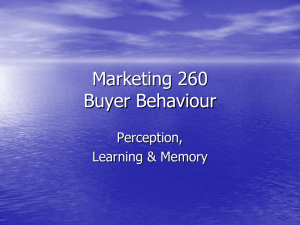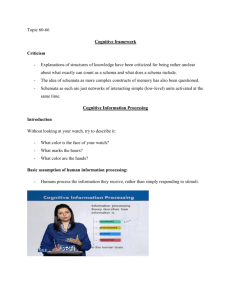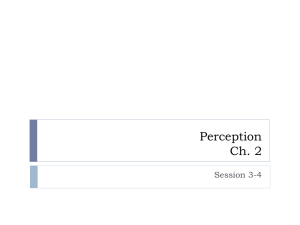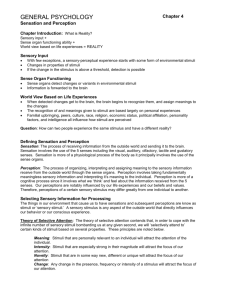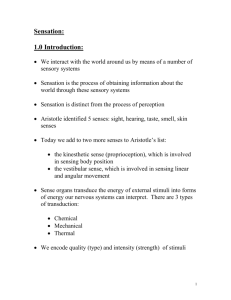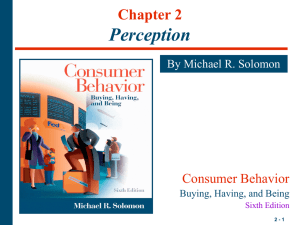Marketing 260 Buyer Behaviour
advertisement
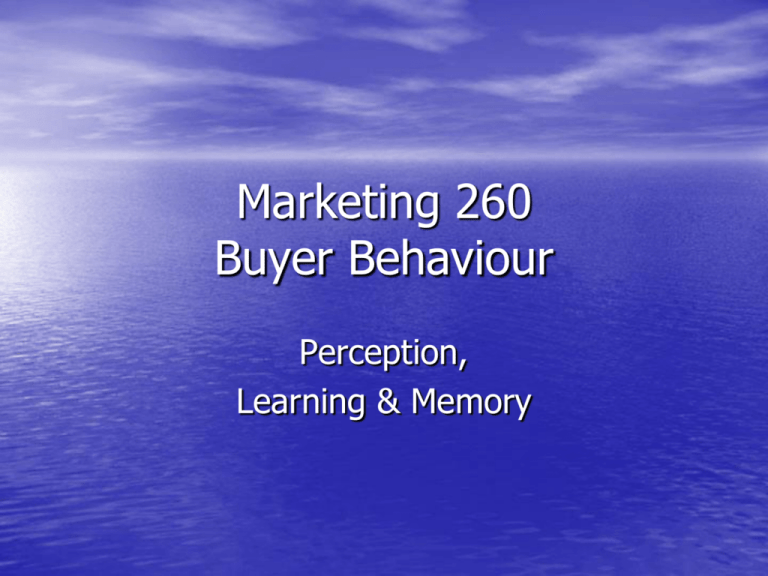
Marketing 260 Buyer Behaviour Perception, Learning & Memory Write down the first thought that pops into your head when you see this image …the FIRST THOUGHT PERCEPTION IS REALITY • How we perceive things is a function of our own personal realities…our history, our culture, our experiences, how we think and feel, our senses or lack thereof. • What we believe to be real is dependent upon our perception of what we know or experience…each person can have a different sense of reality as we are all individuals with a different set of experiences. • Marketing tries to stimulate and awaken perceptions…to change realities, strengthen perceptions, or invoke realities. Milk and Cookies What can we learn from the Chapter Story about Parmalat boxed UHT milk? Perception in Marketing • Dependent upon Human Sensory System • Sensation – “immediate response of our sensory • receptors” (ears, eyes, nose, mouth, fingers…”) Perception – “the process by which sensations are selected, organized and interpreted”. Thus, we are looking at how humans choose which sensations to notice and then add meaning to them. Sensory Systems - Vision • Size • Styling • Brightness • Distinctiveness • Colours Sensory Systems - Smell • Odours and Fragances – Stir emotions or calming – **most primitive part of the brain (limbic system) = ?????????? – Cultural significance of smells? (e.g. Gillette) Sensory Systems-Sounds • www.muzak.com • Music invokes mood – Rock & Roll (anxiety!) – Spas (ocean, water, nature) – Stores, elevators, on hold music, produce aisle Sensory Systems-Touch • Stimulate or Relax moods • Can impact Sales results (e.g. diners touched by • • waiters…bigger tips) Adds personalization…can also offend (how, who, when all are important) Kansei Engineering – “horse and rider as one” (e.g. Mazda and the young) • Textures, sizes heights, lengths, and quality perceptions Sensory Systems-Taste • People form strong preferences for certain tastes • www.alpha-mos.com (electronic tongue) • Awful = powerful • Good = pleasing Exposure • “degree that people notice stimuli” – Why do they observe or ignore • Ignore what is not of interest (e.g. “the pen”) • Sensory Threshold – Absolute (minimum) – Differential (JND – distinguishing stimuli) • Subliminal – Below threshold of recognition (unconscious) • Theatres and popcorn Attention • Extent processing of activity is devoted to a particular stimulus – Focus, isolation, sensory deprivation – Eyeballs vs. dollars?? • Attention Economy – Selectivity = people attend to only a small portion of stimuli • Adaptation – Degree to notice stimuli over time (e.g. blood and gore/shock value) • INTENSITY< DURATION < EXPOSURE (frequency) <RELEVANCE Interpretation • “meanings assigned to stimuli” • Schema (set of beliefs) • Priming (properties of stimulus) e.g. pup vs. master snow blower • Content sensitive (your own reality) Organizational Memory = Gestalt Psychology (p. 55) • “a belief that meaning comes from the totality of a set of stimuli, rather than any individual stimulus” • “principal of closure” (incomplete perceived as complete) • “principle of similarity” • “figure-ground principle” (follow the eye (image focus first)) Interpretation Biases • Semiotics – Signs, symbols and their roles in meaning • Perceptual Positioning – Function (price) vs. Symbolic (what it says about us through our use of it) • Positioning Strategy – Your marketing Mix approach (price, attributes, product class, occasions, users, quality) THANK YOU! LEARNING AND MEMORY CHP 3 Learning: “permanent change in behaviour that is caused by experience, either directly or vicariously’ – It is an ongoing process based on ongoing feedback (+ve or –ve) Behavioral learning theory “result of responses to external stimuli” • Conditioned stimulus (CS) • Unconditioned stimulus (UCS) • Conditioning • Repetition • Stimulus Generalization (similar stimuli/similar response) • Stimulus Discrimination (when similar CS not followed by UCS) Marketing Apps of Conditioning • Repetition • Product Associations (conditioning…pairing with • • stimulus) Generalization – family branding, product lines, licensing/merchandising, look-alikepackaging/knock-offs Discrimination – Instrumental/operant conditioning (go positive avoid negative), fixed interval, fixed ratio (p. 73-75) COGNTIVE LEARNING THEORY “stresses importance of internal mental processes” • Problem solvers vs. reactors – Conscious or not – Mindlessness (info processed automatic and passively) • Observational – Vicarious (not instinctual?) – ATTENTION>RETENTION>PRODUCTION PROCESSES>MOTIVATION>OBS LEARNING (see p. 78) MEMORY IN LEARNING • The Memory Process External Inputs > Encoding > Storage > Retrieval • Encoding – Types of Meaning (sensory/semantic) – Personal Relevance (episodes) • Memory Systems – Sensory – short term (RAM working) – long term (elaborative rehearsal required…think/reflect) MEMORY IN LEARNING • Activation Models of Memory – Associative Networks (e.g. mind mapping) – Spreading Activation (energy spreads across nodes of abstraction in the mind) allows shifting back and forth between levels of meaning (brand vs. ad vs. product category vs. evaluation) – Levels of Knowledge NODES>PROPOSITIONS>SCHEMA Meaning concept> Belief (two nodes linked)> Schema (cognitve framework developed through experience) Elegant>Chanel for elegant women>intuitive…service scripts Measuring Memory for Marketing Stimuli • Recognition vs. Recall – Have you seen it before? – What have you seen? • Problems with memory measures – Response biases (instrument or respondent influences) – Memory lapses (omitting, averaging/normalizing, telescoping) Can we use to our advantage? – Memory for facts vs. feelings (does it measure advertising ability to arouse emotion?) What could we do? THANK YOU for your attention
